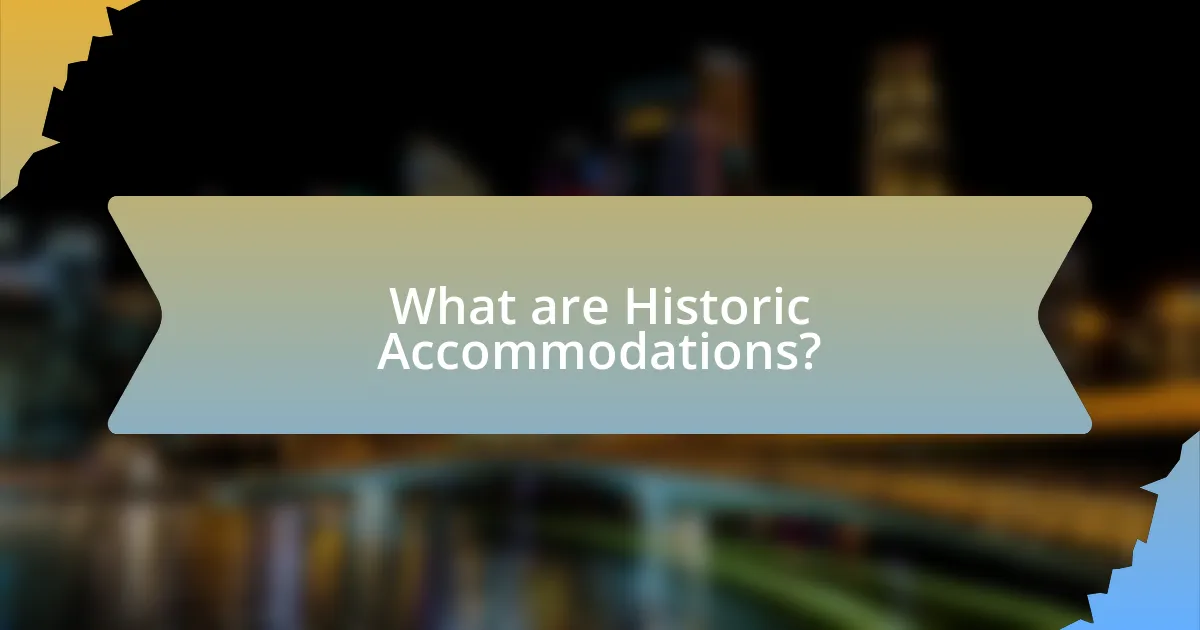Historic accommodations are lodging options situated in buildings of significant historical importance, often featuring unique architectural styles and cultural heritage. This article explores the distinctions between historic accommodations and modern hotels, highlighting their architectural features, cultural significance, and economic contributions. It addresses the challenges these establishments face in a contemporary context, including modernization needs and regulatory issues, while also examining the impact of technology and sustainability on their operations. Additionally, the article discusses marketing strategies and best practices for managing historic accommodations to enhance guest satisfaction and ensure their relevance in today’s competitive hospitality landscape.

What are Historic Accommodations?
Historic accommodations are lodging options that are located in buildings or sites of significant historical importance. These accommodations often preserve the architectural style and cultural heritage of their time, providing guests with a unique experience that reflects the history of the area. For example, many historic accommodations are repurposed mansions, inns, or hotels that date back several centuries, allowing visitors to engage with the past while enjoying modern amenities. The preservation of these sites is often supported by local heritage organizations and tourism boards, emphasizing their value in maintaining cultural identity and promoting historical education.
How do historic accommodations differ from modern hotels?
Historic accommodations differ from modern hotels primarily in their architectural style, ambiance, and the experience they offer. Historic accommodations often feature unique, period-specific designs and furnishings that reflect the culture and history of their location, such as Victorian mansions or ancient inns, while modern hotels typically emphasize contemporary aesthetics, uniformity, and standardized amenities. For instance, a historic inn may have original woodwork and antique decor, providing a sense of nostalgia and authenticity, whereas a modern hotel might focus on sleek lines and technology-driven conveniences. This distinction highlights the appeal of historic accommodations for travelers seeking a connection to the past, contrasting with the efficiency and predictability of modern hotel chains.
What architectural features define historic accommodations?
Historic accommodations are defined by architectural features such as ornate facades, period-specific materials, and distinctive rooflines. These elements often reflect the cultural and historical context of the time period in which they were built, showcasing craftsmanship and design styles unique to their era. For instance, Victorian accommodations typically feature intricate woodwork and decorative trim, while Colonial structures may exhibit symmetry and classical columns. The preservation of these features is crucial for maintaining the historical integrity and character of the accommodations, as evidenced by numerous heritage conservation guidelines that emphasize the importance of original architectural details in historic buildings.
How do the locations of historic accommodations impact their appeal?
The locations of historic accommodations significantly enhance their appeal by providing guests with unique cultural and historical experiences. Proximity to landmarks, natural beauty, and vibrant local communities allows visitors to immerse themselves in the heritage and stories of the area. For instance, accommodations situated near UNESCO World Heritage Sites attract tourists seeking authenticity and connection to history, as evidenced by the increased visitor numbers reported in regions like Rome and Kyoto, where historic hotels are strategically located near ancient ruins and temples. This strategic positioning not only boosts the accommodations’ attractiveness but also contributes to the local economy by encouraging tourism and preserving cultural heritage.
Why are historic accommodations important in today’s society?
Historic accommodations are important in today’s society because they serve as tangible links to cultural heritage and history. These sites provide educational opportunities, allowing individuals to engage with the past and understand the evolution of societal values and architectural styles. For instance, UNESCO recognizes over 1,100 World Heritage Sites, which attract millions of tourists annually, contributing significantly to local economies. Furthermore, historic accommodations often promote sustainable tourism practices, preserving local culture while minimizing environmental impact. This dual role of education and economic contribution underscores their relevance in contemporary society.
What cultural significance do historic accommodations hold?
Historic accommodations hold significant cultural value as they embody the architectural styles, traditions, and social histories of their respective eras. These establishments serve as tangible links to the past, allowing individuals to experience and understand the cultural narratives that shaped communities. For instance, many historic hotels and inns reflect the design aesthetics and craftsmanship of their time, showcasing local materials and construction techniques that are often unique to specific regions. Furthermore, they often host events and activities that celebrate local customs and heritage, thereby fostering community identity and continuity. The preservation of these accommodations contributes to cultural tourism, which can enhance local economies while promoting awareness and appreciation of historical contexts.
How do historic accommodations contribute to local economies?
Historic accommodations contribute to local economies by attracting tourists, which generates revenue and creates jobs. For instance, a study by the National Trust for Historic Preservation found that heritage tourism can significantly boost local economies, with visitors spending an average of $1,000 per trip, benefiting local businesses such as restaurants, shops, and services. Additionally, historic accommodations often require local labor for maintenance and operations, further stimulating employment opportunities within the community.

What challenges do historic accommodations face in a modern world?
Historic accommodations face significant challenges in a modern world, primarily due to the need for modernization while preserving their historical integrity. These establishments often struggle with outdated infrastructure that does not meet contemporary safety and accessibility standards, which can deter potential guests. Additionally, the financial burden of maintaining and restoring historic properties can be substantial, as they require specialized materials and skilled labor for renovations. Furthermore, competition from modern hotels and alternative lodging options, such as short-term rentals, poses a threat to their market viability. According to the National Trust for Historic Preservation, many historic hotels report declining occupancy rates as travelers increasingly favor newer, more technologically equipped accommodations.
How is technology impacting the operation of historic accommodations?
Technology is significantly enhancing the operation of historic accommodations by improving guest experiences and operational efficiency. For instance, the integration of online booking systems allows historic hotels to reach a broader audience, increasing occupancy rates. Additionally, smart room technologies, such as automated lighting and climate control, provide modern conveniences while preserving the historical integrity of the accommodations. A study by the American Hotel and Lodging Educational Institute found that 70% of guests prefer properties that offer technological amenities, indicating that technology not only attracts visitors but also meets their evolving expectations. Furthermore, digital marketing strategies enable historic accommodations to showcase their unique heritage and attract niche markets, thereby ensuring their sustainability in a competitive landscape.
What technological advancements are being integrated into historic accommodations?
Technological advancements integrated into historic accommodations include smart home technology, energy-efficient systems, and augmented reality experiences. Smart home technology allows for automated lighting, climate control, and security systems, enhancing guest comfort while preserving the building’s historical integrity. Energy-efficient systems, such as modern HVAC and insulation, reduce energy consumption and costs, aligning with sustainability goals. Augmented reality experiences provide interactive historical tours, enriching the guest experience by blending technology with the site’s heritage. These advancements not only improve operational efficiency but also attract a tech-savvy clientele, ensuring the relevance of historic accommodations in a modern world.
How do guests perceive technology in historic settings?
Guests generally perceive technology in historic settings as a valuable enhancement that can improve their experience while preserving the authenticity of the environment. Many visitors appreciate modern conveniences such as Wi-Fi, smart room controls, and digital guides, which can provide essential information without detracting from the historical ambiance. Research indicates that 70% of travelers prefer accommodations that blend modern technology with traditional aesthetics, highlighting a demand for seamless integration. This perception is supported by studies showing that guests are more likely to return to historic accommodations that effectively utilize technology to enhance comfort and accessibility while maintaining the site’s historical integrity.
What regulatory issues affect historic accommodations?
Regulatory issues affecting historic accommodations primarily include preservation laws, zoning regulations, and accessibility requirements. Preservation laws, such as the National Historic Preservation Act in the United States, mandate that any alterations to historic properties must maintain their historical integrity, which can limit renovation options. Zoning regulations often restrict the types of businesses that can operate in historic districts, impacting the viability of accommodations. Additionally, accessibility requirements under the Americans with Disabilities Act necessitate modifications that may conflict with preservation standards, creating challenges for compliance. These regulatory frameworks collectively shape how historic accommodations can be maintained and operated in a modern context.
What preservation laws must historic accommodations comply with?
Historic accommodations must comply with the National Historic Preservation Act (NHPA) and local preservation ordinances. The NHPA, enacted in 1966, establishes a framework for preserving historical sites and requires federal agencies to consider the effects of their actions on historic properties. Additionally, many states and municipalities have their own preservation laws that may impose specific requirements for maintenance, restoration, and alterations of historic structures, ensuring that any changes respect the building’s historical integrity. Compliance with these laws is essential for maintaining eligibility for federal and state tax credits and grants aimed at preserving historic properties.
How do zoning regulations impact the operation of historic accommodations?
Zoning regulations significantly impact the operation of historic accommodations by dictating land use, building modifications, and operational guidelines. These regulations often restrict the types of activities that can occur within historic districts, which can limit the ability of accommodations to adapt to modern hospitality trends. For instance, many zoning laws require that any renovations to historic properties maintain their original architectural features, which can increase costs and complicate updates necessary for modern guest expectations. Additionally, zoning regulations may impose restrictions on signage, parking, and noise levels, further influencing how historic accommodations can operate and market themselves. Such regulations are designed to preserve the character of historic areas, but they can also create challenges for property owners seeking to balance preservation with profitability.

What trends are shaping the future of historic accommodations?
Sustainability and technology integration are key trends shaping the future of historic accommodations. Many historic properties are adopting eco-friendly practices, such as energy-efficient systems and sustainable materials, to appeal to environmentally conscious travelers. For instance, a report by the Global Sustainable Tourism Council indicates that 70% of travelers prefer accommodations that demonstrate sustainability efforts. Additionally, the use of technology, such as mobile check-ins and smart room features, enhances guest experiences while preserving the unique character of historic sites. This combination of sustainability and technology not only attracts a modern clientele but also ensures the longevity and relevance of historic accommodations in a competitive market.
How is sustainability influencing historic accommodations?
Sustainability is significantly influencing historic accommodations by driving the adoption of eco-friendly practices and renovations that preserve cultural heritage while minimizing environmental impact. Many historic hotels and lodgings are implementing energy-efficient systems, such as solar panels and LED lighting, to reduce their carbon footprint. For instance, the National Trust for Historic Preservation reports that integrating sustainable practices can enhance the longevity of historic structures, ensuring they remain viable for future generations. Additionally, sustainable tourism initiatives encourage the use of local materials and resources, which not only supports the local economy but also maintains the authenticity of the accommodations. This shift towards sustainability is reshaping how historic accommodations operate, aligning them with modern environmental standards and consumer expectations.
What eco-friendly practices are being adopted by historic accommodations?
Historic accommodations are adopting various eco-friendly practices, including energy-efficient retrofitting, water conservation systems, and the use of sustainable materials. Many historic hotels are implementing solar panels and LED lighting to reduce energy consumption, while also installing low-flow fixtures to minimize water usage. Additionally, some properties are sourcing local and organic products for their restaurants, thereby supporting local economies and reducing carbon footprints. These practices not only preserve the environment but also enhance the guest experience by promoting sustainability.
How does sustainability enhance the guest experience in historic settings?
Sustainability enhances the guest experience in historic settings by promoting environmental responsibility and preserving cultural heritage. Guests increasingly prefer accommodations that prioritize eco-friendly practices, such as energy efficiency and waste reduction, which contribute to a more authentic and meaningful stay. For instance, historic hotels that utilize renewable energy sources and locally sourced materials not only reduce their carbon footprint but also create a unique atmosphere that reflects the local culture and history. This alignment with sustainable practices can lead to higher guest satisfaction, as evidenced by a study from the Cornell University School of Hotel Administration, which found that 70% of travelers are more likely to choose hotels that demonstrate a commitment to sustainability.
What role does marketing play in the future of historic accommodations?
Marketing plays a crucial role in the future of historic accommodations by enhancing visibility and attracting a diverse clientele. As consumer preferences shift towards unique and authentic experiences, effective marketing strategies can highlight the distinctive features and historical significance of these accommodations. For instance, utilizing digital platforms and social media can showcase the unique stories and heritage of historic properties, appealing to travelers seeking immersive experiences. According to a study by the American Hotel and Lodging Educational Institute, 70% of travelers prioritize unique accommodations, indicating that targeted marketing can significantly influence booking decisions. Thus, strategic marketing not only promotes historic accommodations but also ensures their relevance in a competitive hospitality landscape.
How can social media be leveraged to promote historic accommodations?
Social media can be leveraged to promote historic accommodations by creating engaging content that highlights their unique features and stories. Platforms like Instagram and Facebook allow for visually appealing posts showcasing the architecture, history, and ambiance of these accommodations, attracting potential guests. For instance, using hashtags related to travel and history can increase visibility, while user-generated content, such as guest reviews and photos, can enhance credibility and encourage bookings. According to a study by the Pew Research Center, 69% of adults in the U.S. use social media, making it a powerful tool for reaching a broad audience interested in travel experiences.
What unique selling points should be highlighted in marketing historic accommodations?
Historic accommodations should highlight their rich heritage, unique architecture, and immersive experiences as unique selling points. These properties often feature distinctive design elements that reflect the culture and history of their location, attracting guests seeking authenticity. For instance, accommodations in restored castles or historic inns provide guests with a tangible connection to the past, enhancing their stay with stories and experiences that modern hotels cannot replicate. Additionally, many historic accommodations offer personalized service and local insights, further enriching the guest experience. According to a study by the National Trust for Historic Preservation, travelers are increasingly drawn to unique lodging options that provide a sense of place, with 70% of respondents expressing a preference for accommodations that reflect local history and culture.
What are the best practices for managing historic accommodations in a modern context?
The best practices for managing historic accommodations in a modern context include preserving architectural integrity, integrating modern amenities sensitively, and engaging the community. Preserving architectural integrity involves maintaining original features and materials, which can enhance the property’s historical value and appeal; for instance, the National Park Service emphasizes the importance of adhering to the Secretary of the Interior’s Standards for Rehabilitation. Integrating modern amenities sensitively ensures that guests enjoy contemporary comforts without compromising the historic character; this can be achieved through discreet installations that do not alter the building’s façade. Engaging the community fosters local support and can enhance the guest experience by promoting local culture and history, as seen in successful heritage tourism initiatives that involve local stakeholders. These practices collectively ensure that historic accommodations remain relevant and sustainable in today’s market.
How can owners balance preservation with modernization in historic accommodations?
Owners can balance preservation with modernization in historic accommodations by implementing adaptive reuse strategies that respect the original architecture while integrating modern amenities. This approach allows for the retention of historical elements, such as facades and structural features, while updating interiors with contemporary comforts like energy-efficient systems and modern furnishings. For instance, the National Trust for Historic Preservation emphasizes that successful projects often involve collaboration with preservationists and architects who specialize in historic properties, ensuring that renovations enhance rather than detract from the building’s historical significance.
What strategies can enhance guest satisfaction in historic accommodations?
To enhance guest satisfaction in historic accommodations, implementing personalized guest experiences is crucial. Personalization can include tailored welcome amenities, customized itineraries that highlight local history, and attentive service that addresses individual preferences. Research indicates that 80% of consumers are more likely to make a purchase when brands offer personalized experiences, demonstrating the effectiveness of this strategy in the hospitality sector. Additionally, maintaining the historical integrity of the property while integrating modern amenities, such as high-speed internet and updated bathrooms, can significantly improve guest comfort and satisfaction. A study by the American Hotel and Lodging Educational Institute found that guests value a blend of historical charm and contemporary convenience, which can lead to higher satisfaction ratings and repeat visits.